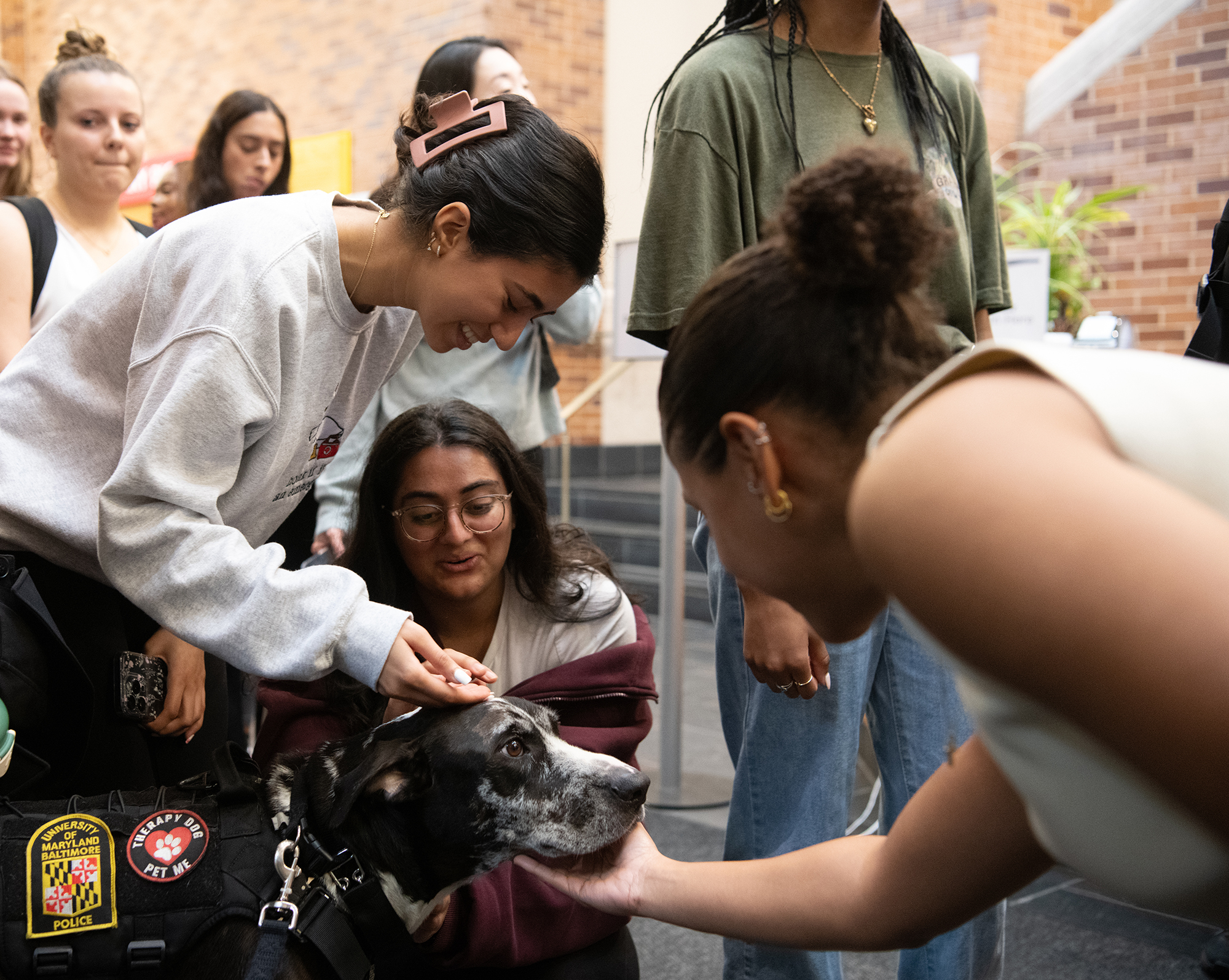Every Dog Has Its Day: Comfort K9 Poe Is the Latest to Serve in UMB Police’s 50 Years
July 14, 2025 Carin Cardella
Read about how Poe provides an opportunity for police to connect with the community and makes his handler more approachable as an officer in the latest issue of “CATALYST.”
Photo: Students pet Poe, UMB’s third comfort K9. Photo by Matthew D’Agostino
“I wish I could pet your dog.”
PFC Anthony Summers hears those words countless times throughout his day as he walks across the University of Maryland, Baltimore (UMB) campus with his K9, Poe. But Poe isn’t a traditional police dog. He’s a comfort K9. “You can pet him!” Summers, Poe’s handler, replies happily.
Poe, a 5-year-old Great Dane mix, is the third comfort K9 for UMB Police and Public Safety. The department’s first dog, Lexi, joined the department in June 2019. She was just the third university police department comfort K9 in the nation at the time. Now, dozens of universities have welcomed therapy dogs onto their campuses.
“The program is right in line with our University’s core values,” says Thomas Leone, MSL, assistant vice president for public safety and chief of police. “Poe can improve our community’s well-being by just showing up. That’s pretty amazing.”
Comfort K9s, or therapy dogs, are trained to provide stress relief and affection to people dealing with anxiety, depression, trauma, or mental illness. Whether it’s a student studying for exams, an employee on a project deadline, or a community member going through a difficult time, Poe and Summers are there to help.
“Poe is not only the unofficial mascot of our campus here in Baltimore, he’s a cherished member of the community,” says Tyler Mazur, a University of Maryland Francis King Carey School of Law student who earned his JD this spring. “Growing up with dogs, I have always appreciated the positive impact that they can have on mental health and quality of life. Poe is a dog that fills that space in our hearts — especially in this fast-paced environment. I am always as thrilled to see him as he is to see me. He shows his excitement with lots of love and tail-wagging!”
Making Officers More Approachable
This year, UMB Police and Public Safety is celebrating 50 years since police officers joined the department in 1975. The department’s first K9 joined the department in 1977. Smoke, an 18-month German shepherd, was donated to the police department after it put an ad in the University newsletter seeking a dog. Smoke and his handler, Officer J.K. Davis Jr., went through K9 training together with the Baltimore Police Department.
While both police dogs have served UMB, their missions differ: Smoke was used to help deter crime, and Poe is a part of the department’s Community Outreach and Support Team (COAST), helping to build positive relationships with the University community and beyond.
“Historically, seeing a dog with a police officer was a reason not to approach,” Leone says. “We’re changing that narrative.”
Summers agrees. “Poe provides an opportunity to connect with our community,” he says. “There are patches for his vest that say, ‘Pet me.’ You see people light up. And that makes me more approachable as a police officer.”
All of UMB’s comfort K9s have come from Paws and Stripes College, a program run by the Brevard County Sheriff’s Office in Florida. Shelter dogs at a significant risk of being euthanized are paired with inmates for eight weeks and go through basic obedience training. When he traveled to meet Poe, Summers said he received in-depth training.
“I learned how to read people, how to identify people’s feelings, and also how to identify Poe’s mood. A lot of people don’t understand that he has a mood as well,” Summers says. “He may be tired. I have to be the one to notice that and let him rest.”
The latest issue of "CATALYST" magazine highlights the School of Pharmacy's Mass Spectrometry Center; the Costa Rica Faculty Development Institute; Bill Joyner, JD, MSW, of the Office of Community and Civic Engagement; the School of Social Work's B'more for Healthy Babies; the School of Medicine's work to develop physicians for rural areas; facts about the Universities at Shady Grove, and much more.